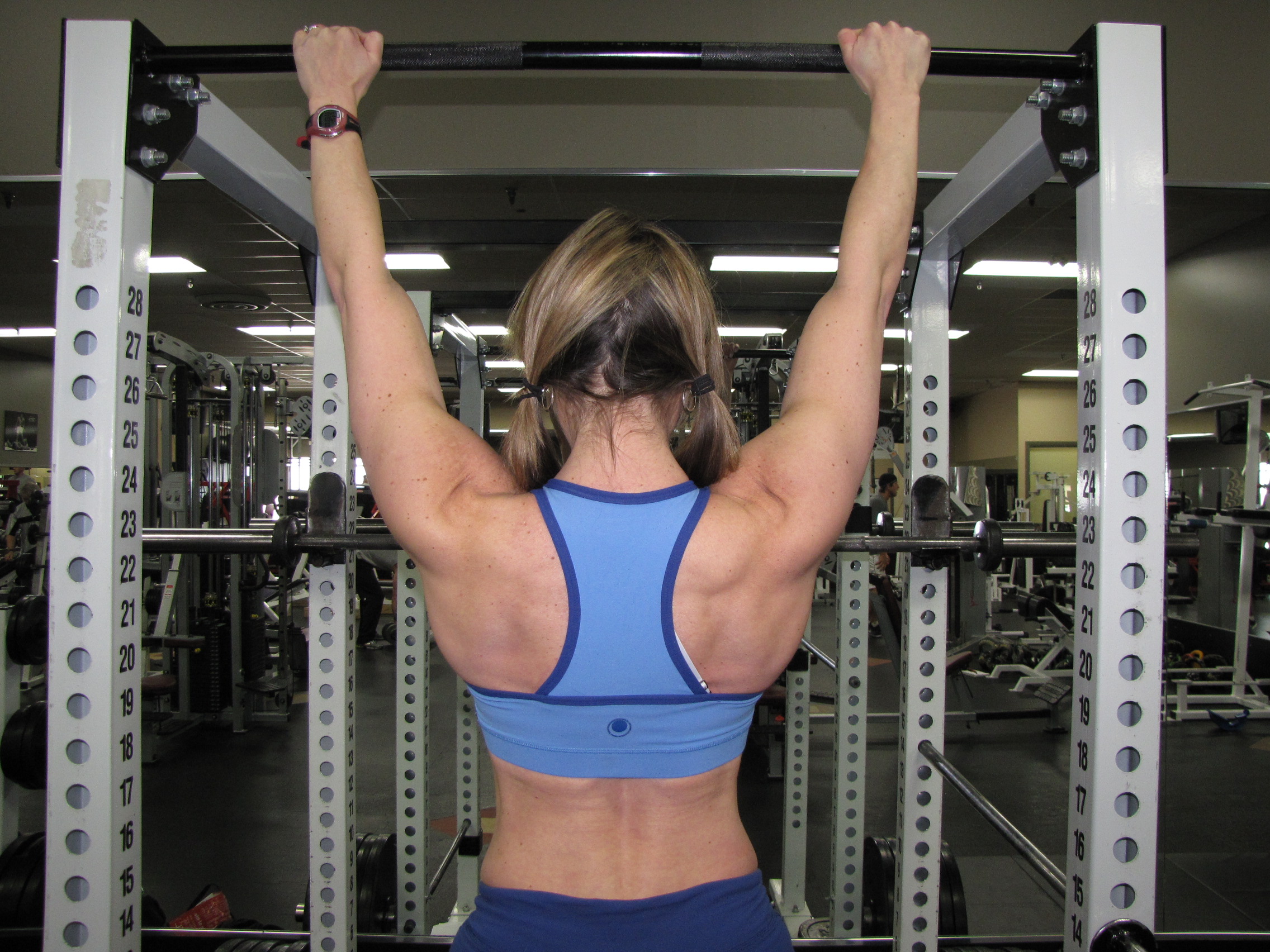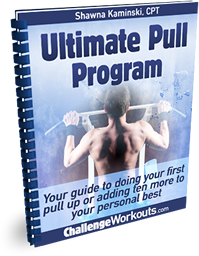Do More Pull-Ups
 I’m Shawna K and I love to do pull ups. I often get the eye roll and the ‘ya right, not for me’ response when I make the suggestion to include pull ups in a workout.
I’m Shawna K and I love to do pull ups. I often get the eye roll and the ‘ya right, not for me’ response when I make the suggestion to include pull ups in a workout.
Did you know that only about 5% of the population can actually do a pull up? All the more reason to learn how to do one (or improve the number of pull ups you can do…)
You may ask, ‘why pull ups?’
Well, the pull up is a beautiful thing. It’s simply bad ass. Not only does the pull up sculpt your body to look great, you’ll look great doing this impressive move.
It does take some finesse though so I have a few tips and tricks to help you whether you’ve never done one before or you want to increase the quality and quantity of pull ups you can do.
First of all, let’s talk body position…
Finding the correct body position will help you to learn the pull up much faster. Most people will try to use get their chin OVER the bar instead of bringing the chest UNDER the bar and they mostly use their arms rather than using the back muscles to do the work. This will get you NO WHERE FAST.
You need to get your body UNDER the bar like this:
You need to position yourself so that you’re looking up and you’re ready to engage the BACK muscles, NOT just the muscles of the arms.
Remarkably, many people can’t ‘find’ their back muscles, so an exercise that helps isolate the back muscles is called ‘scapular retraction’. This involves simply hanging from a suspended bar.
As you hang, look up and think about inwardly rotating your scapula, or squeezing your shoulder blades together. This will cause you to press the chest forward. You should start to feel a slight elevation of your body, even if you can’t move your entire body up to the bar yet.
This improved body position will address the common error of inwardly rotating the shoulders to pull the body up. The back is much stronger than other muscles of the chest and arms for this move and you’ll be more successful when you engage the muscles of the back.
Next, let’s talk about eccentric training…
Whether you’re a beginner or a seasoned veteran of the pull up move, the lengthening (or lowering phase) of the pull up is actually the strengthening phase of the movement. Most folks think that getting the chin up to the bar is the most important phase.
Wrong.
The slow decent from the bar will strengthen your muscles most.
There are a variety of ways that you can work the eccentric contraction when doing a pull up. You can do assisted pull ups, jump pull ups, band assisted pull ups, suspended pull ups, inverted rows, weighted pull ups (all of these are discussed in my program by the way).
You can watch my video here:
Here is one of my favorite moves that will help the beginner achieve a pull up:
The Beginner: Totally Assisted Pull-up
• Grasp the bar with an overhand, wide grip.
• Step up off a platform to bring yourself up until your chest is under the bar.
• You will step up with your entire weight on your legs and return to the full hang trying to take most of the weight with your upper body.
• Return to full hanging position with control.
‘Controlled’ Cheating Methods
Many folks only count a pull up when it’s done in the strictest of fashion. There’s nothing wrong with using some cheating methods in training then doing the strictest of form to count your personal best on a pull up ‘test’.
Since the pull-up is one of the ONLY exercises where you need to move your ENTIRE bodyweight each rep, you can’t use traditional ‘progressive resistance’ when training your pull ups. You either can do a pull up or you can’t.
I have a few methods to ‘cheat’ on your pull up that won’t put you at risk for injury (which is the biggest reason you need to train traditional progressive resistance exercises with the strictest of form).
One method of ‘cheating’ is the band-assisted pull up. Simply loop a large band over the pull up bar, then around the knees to help suspend your body weight. Use the band to help you get up to the bar, then take all your weight on the descent. Like I said earlier, it’s actually the eccentric contraction, or the lowering from the bar that causes the greatest strengthening, so the band assist is a brilliant way to help you with eccentric training.
The Kip
Many people wouldn’t consider using power from the lower body to help with the pull up, but by adding a ‘kip’, you can do just that. This is another ‘controlled cheating’ method you can employ to improve your pull up power.
A kip is done by simply driving forward with the knees as you pull your chest directly under the bar. This transfers power to the hips and to the upper body to provide some momentum in the concentric (lifting) phase of the movement. Once up to the bar, make sure to lower the body slowly to work the eccentric contraction.
Hanging Leg Raises
Not surprising, core strength is helpful to increase your pull up prowess. A strong core helps maintain the proper body alignment in order for you to engage your back muscles.
A good way to train the core and at the same time increase grip and back strength is to do hanging leg raises. Many people tend to just work their hip flexors when doing leg raises. The point of the leg raise is to contract the abdominal wall and allow the hips to roll. It’s a matter of pressing the belly button in towards the spine to contract the core and not just lift the legs up.
These are just a few tips that will help you learn the pull up or truly rock the pull up bar. I have a ton more that can have you going from pull up ‘Zero’ to ‘Hero’. If this sort of thing excites you, check out my program HERE and see if it’s right for you.